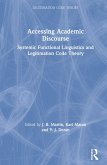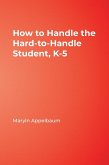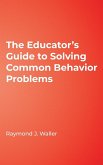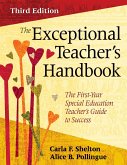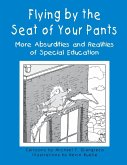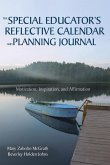Victor Nolet, Margaret J. McLaughlin
Accessing the General Curriculum
Including Students With Disabilities in Standards-Based Reform
Schade – dieser Artikel ist leider ausverkauft. Sobald wir wissen, ob und wann der Artikel wieder verfügbar ist, informieren wir Sie an dieser Stelle.
Victor Nolet, Margaret J. McLaughlin
Accessing the General Curriculum
Including Students With Disabilities in Standards-Based Reform
- Gebundenes Buch
- Merkliste
- Auf die Merkliste
- Bewerten Bewerten
- Teilen
- Produkt teilen
- Produkterinnerung
- Produkterinnerung
Featuring updated strategies for fitting special education into frameworks created by standards and assessments, this indispensable resource shows teachers how to achieve expected results with all students.
Andere Kunden interessierten sich auch für
![Accessing Academic Discourse Accessing Academic Discourse]() Accessing Academic Discourse199,99 €
Accessing Academic Discourse199,99 €![How to Handle the Hard-to-Handle Student, K-5 How to Handle the Hard-to-Handle Student, K-5]() Maryln AppelbaumHow to Handle the Hard-to-Handle Student, K-573,99 €
Maryln AppelbaumHow to Handle the Hard-to-Handle Student, K-573,99 €![The Educator's Guide to Solving Common Behavior Problems The Educator's Guide to Solving Common Behavior Problems]() Raymond J. WallerThe Educator's Guide to Solving Common Behavior Problems65,99 €
Raymond J. WallerThe Educator's Guide to Solving Common Behavior Problems65,99 €![The Exceptional Teacher's Handbook The Exceptional Teacher's Handbook]() Carla F. SheltonThe Exceptional Teacher's Handbook43,99 €
Carla F. SheltonThe Exceptional Teacher's Handbook43,99 €![Flying by the Seat of Your Pants Flying by the Seat of Your Pants]() Michael GiangrecoFlying by the Seat of Your Pants27,99 €
Michael GiangrecoFlying by the Seat of Your Pants27,99 €![The Special Educator's Reflective Calendar and Planning Journal The Special Educator's Reflective Calendar and Planning Journal]() Mary Zabolio McGrathThe Special Educator's Reflective Calendar and Planning Journal32,99 €
Mary Zabolio McGrathThe Special Educator's Reflective Calendar and Planning Journal32,99 €
Featuring updated strategies for fitting special education into frameworks created by standards and assessments, this indispensable resource shows teachers how to achieve expected results with all students.
Produktdetails
- Produktdetails
- Verlag: Corwin
- 2. Auflage
- Seitenzahl: 144
- Erscheinungstermin: 9. Juni 2005
- Englisch
- Abmessung: 286mm x 221mm x 13mm
- Gewicht: 641g
- ISBN-13: 9781412916486
- ISBN-10: 1412916488
- Artikelnr.: 21397200
- Herstellerkennzeichnung
- Libri GmbH
- Europaallee 1
- 36244 Bad Hersfeld
- gpsr@libri.de
- Verlag: Corwin
- 2. Auflage
- Seitenzahl: 144
- Erscheinungstermin: 9. Juni 2005
- Englisch
- Abmessung: 286mm x 221mm x 13mm
- Gewicht: 641g
- ISBN-13: 9781412916486
- ISBN-10: 1412916488
- Artikelnr.: 21397200
- Herstellerkennzeichnung
- Libri GmbH
- Europaallee 1
- 36244 Bad Hersfeld
- gpsr@libri.de
Victor W. Nolet is Director of Assessment and Evaluation for the Woodring College of Education at Western Washington University. He received his Ph.D. from the University of Oregon. His current interests include the impact of teacher education programs on P-12 student outcomes and the impact of accountability systems on students with disabilities. Address: Victor Nolet, Woodring College of Education, 251F Miller Hall, Western Washington University, Bellingham, WA. 98225.
Introduction Acknowledgments 1. Access to the General Curriculum: Why it is More Important Than Ever Before The IDEA and Access to the General Curriculum The No Child Left Behind Act The Link Between "Standards" and "Curriculum" A New Way to Think About Special Education 2. The Nature of Curriculum Multiple Types of Curriculum The Core Elements of Curriculum What is the Purpose of Curriculum? Curriculum Involves a Domain Curriculum and Time Finding the General Curriculum Chapter Summary 3. The Learning-Teaching Connection Learning Research and Implications for Teaching Help Students Develop Meaningful Patterns of Information Creating Experts Teach to Improve Your Student
s Memory Help Students Attend to What You Want Them to Learn Make Effective Use of Practice Make Effective Use of Scaffolding Help Students Manage Their Own Learning Teach for Transfer and Generalization The Learning-Teaching Connection 4. Assessment That Supports Access to the General Curriculum Assessment and Decision-Making What Will Typical Students Be Expected to Do During the Timeframe Addressed by the IEP What is the Student
s Present Level of Performance in the General Curriculum? In What Ways is the Student
s Disability Impacting Performance? Is the Student Making Progress in the General Education Curriculum? 5. Access to Curriculum and the Individual Education Program Curriculum Access on a Continuum Universal Design for Learning Multiple Means of Representation Accommodations Modifications Accommodations and Modifications and Assessment Special Education and Related Services 6. A Decision-Making Process for Creating IEPs That Lead to Curriculum Access Step 1: Instructional Assessment Step 2: Choosing the Standards and Identifying Supports Step 3: Creating IEP Goals, Objectives, and Benchmarks The Relationship Between Objectives and Benchmarks References Index
s Memory Help Students Attend to What You Want Them to Learn Make Effective Use of Practice Make Effective Use of Scaffolding Help Students Manage Their Own Learning Teach for Transfer and Generalization The Learning-Teaching Connection 4. Assessment That Supports Access to the General Curriculum Assessment and Decision-Making What Will Typical Students Be Expected to Do During the Timeframe Addressed by the IEP What is the Student
s Present Level of Performance in the General Curriculum? In What Ways is the Student
s Disability Impacting Performance? Is the Student Making Progress in the General Education Curriculum? 5. Access to Curriculum and the Individual Education Program Curriculum Access on a Continuum Universal Design for Learning Multiple Means of Representation Accommodations Modifications Accommodations and Modifications and Assessment Special Education and Related Services 6. A Decision-Making Process for Creating IEPs That Lead to Curriculum Access Step 1: Instructional Assessment Step 2: Choosing the Standards and Identifying Supports Step 3: Creating IEP Goals, Objectives, and Benchmarks The Relationship Between Objectives and Benchmarks References Index
Introduction Acknowledgments 1. Access to the General Curriculum: Why it is More Important Than Ever Before The IDEA and Access to the General Curriculum The No Child Left Behind Act The Link Between "Standards" and "Curriculum" A New Way to Think About Special Education 2. The Nature of Curriculum Multiple Types of Curriculum The Core Elements of Curriculum What is the Purpose of Curriculum? Curriculum Involves a Domain Curriculum and Time Finding the General Curriculum Chapter Summary 3. The Learning-Teaching Connection Learning Research and Implications for Teaching Help Students Develop Meaningful Patterns of Information Creating Experts Teach to Improve Your Student
s Memory Help Students Attend to What You Want Them to Learn Make Effective Use of Practice Make Effective Use of Scaffolding Help Students Manage Their Own Learning Teach for Transfer and Generalization The Learning-Teaching Connection 4. Assessment That Supports Access to the General Curriculum Assessment and Decision-Making What Will Typical Students Be Expected to Do During the Timeframe Addressed by the IEP What is the Student
s Present Level of Performance in the General Curriculum? In What Ways is the Student
s Disability Impacting Performance? Is the Student Making Progress in the General Education Curriculum? 5. Access to Curriculum and the Individual Education Program Curriculum Access on a Continuum Universal Design for Learning Multiple Means of Representation Accommodations Modifications Accommodations and Modifications and Assessment Special Education and Related Services 6. A Decision-Making Process for Creating IEPs That Lead to Curriculum Access Step 1: Instructional Assessment Step 2: Choosing the Standards and Identifying Supports Step 3: Creating IEP Goals, Objectives, and Benchmarks The Relationship Between Objectives and Benchmarks References Index
s Memory Help Students Attend to What You Want Them to Learn Make Effective Use of Practice Make Effective Use of Scaffolding Help Students Manage Their Own Learning Teach for Transfer and Generalization The Learning-Teaching Connection 4. Assessment That Supports Access to the General Curriculum Assessment and Decision-Making What Will Typical Students Be Expected to Do During the Timeframe Addressed by the IEP What is the Student
s Present Level of Performance in the General Curriculum? In What Ways is the Student
s Disability Impacting Performance? Is the Student Making Progress in the General Education Curriculum? 5. Access to Curriculum and the Individual Education Program Curriculum Access on a Continuum Universal Design for Learning Multiple Means of Representation Accommodations Modifications Accommodations and Modifications and Assessment Special Education and Related Services 6. A Decision-Making Process for Creating IEPs That Lead to Curriculum Access Step 1: Instructional Assessment Step 2: Choosing the Standards and Identifying Supports Step 3: Creating IEP Goals, Objectives, and Benchmarks The Relationship Between Objectives and Benchmarks References Index


